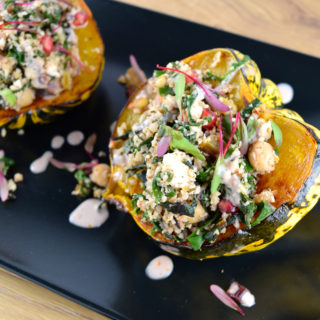Middle Eastern Stuffed Squash with Chickpeas and Chard

Prep time
Cook time
Total time
Author: Good Health Gourmet
Recipe type: Entrée
Cuisine: Middle Eastern, Vegetarian
Yield: 6 servings
Ingredients
- For sauce
- 1 clove garlic, finely grated
- 2 ounces (¼ cup) tahini paste
- 15 ml (1 tablespoon) warm water
- Finely minced zest of 2 blood oranges (about 5 ½ ounces each), one teaspoon reserved for stuffing
- 90 ml (6 tablespoons) fresh blood orange juice
- Kosher salt
- Freshly ground pepper
- For squash
- 3 small winter squash (about 1 ½ lbs each), halved vertically & cleaned, seeds reserved*
- 15ml (1 tablespoon) olive oil
- Kosher salt and freshly ground pepper
- For stuffing
- 45 grams (⅓ cup) raw pine nuts**
- 1 lb cauliflower florets (from ½ medium 6-inch head, trimmed and cored)
- 30 ml (2 tablespoons) olive oil, coconut oil or ghee
- ½ cup diced red onion (about ½ of a small onion)
- Kosher salt
- 2 tablespoons salt-free za’atar***
- 1 ½ teaspoons aleppo chile flakes
- 1 tablespoon fresh thyme leaves, minced
- 2 teaspoons minced or grated garlic (2 large cloves)
- 1 bunch chard (1 - 1 ½ lbs) washed and dried, stems diced, leaves sliced into ribbons
- 14 ounces cooked chickpeas (from 4.5 ounces dried or one drained can)
- 120 ml (½ cup) vegetable stock
- 2 teaspoons ground sumac
- Freshly ground black pepper
- 1 teaspoon finely minced blood orange zest (reserved from sauce)
- Seeds of one small pomegranate (about 1 cup)
- 2 tablespoons chopped mint leaves
- 1 tablespoon chopped Italian parsley leaves
- 3 ounces (½ cup) crumbled sheep’s milk feta or dairy-free alternative
Procedure
- Make the sauce: In a small bowl whisk together garlic, tahini, warm water, all but one teaspoon orange zest, and orange juice. Season to taste with salt and pepper. (If sauce is too thick for your liking, add more orange juice or water to reach desired consistency). Set aside.
- Roast the squash: Arrange two oven racks in upper middle and lower middle positions, and preheat oven to 400°F. Rub the exposed flesh of the squash with olive oil and season with salt and pepper. Place squash cut-side down on an oiled baking sheet and roast on upper middle rack for 25-30 minutes or until lightly browned and tender when pierced with a fork.
- While squash is roasting, make the stuffing: Spread the nuts on a sheet pan and toast them in the oven on the lower-middle rack for about 5 minutes or until lightly golden, tossing once. (Keep a close eye on them because they burn easily.) Set nuts aside to cool.
- Pulse the cauliflower florets in a food processor or blender until they break down into couscous-sized bits (do not puree). You should end up with about 4 cups of “couscous.” Set aside.
- In a dutch oven or large high-sided sauté pan, heat 1 tablespoon oil or ghee over medium heat. Add diced onion and pinch of salt and sauté until softened, 4-5 minutes. Add za’atar, aleppo flakes, thyme, garlic, and chard stems (not leaves), and sauté for 1-2 minutes, tossing/stirring occasionally, until fragrant. Add chickpeas, vegetable stock, 1 teaspoon salt, and cauliflower. Continue to cook, stirring occasionally, 5 minutes or until stock is absorbed and cauliflower couscous is tender. Add chard leaves and sumac, toss to combine, and cook until chard leaves are wilted, 1-2 minutes. Season to taste with salt and pepper.
- Remove from heat and stir in orange zest, pomegranate seeds, mint, feta and pine nuts.
- Serve: Divide stuffing among squash halves and drizzle with orange tahini sauce. Serve immediately, passing additional sauce on the side.
Notes
*Don’t throw out those squash seeds! Rinse and dry them well, toss with a bit of oil and your favorite seasonings, and roast in a 300-degree oven for 25-30 minutes, tossing occasionally. Snack away.
**When purchasing pine nuts, read labels to learn their country of origin and steer clear of nuts from China, Korea or Russia. There’s an unpleasant condition called “pine mouth” or “pine nut syndrome” that can occur from ingesting a certain species of Chinese pine nuts (and they’re often processed in Russia and Korea). While not at all dangerous, pine mouth makes everything you eat taste bitter and metallic for 1-2 weeks. Not fun! So make an effort to seek out European or Mediterranean pine nuts.
***Some companies add a lot of salt to their za’atar, making it difficult to balance the seasoning in a recipe without over-salting. I either mix my own za’atar or buy salt-free blends, and I recommend that you do the same.
**When purchasing pine nuts, read labels to learn their country of origin and steer clear of nuts from China, Korea or Russia. There’s an unpleasant condition called “pine mouth” or “pine nut syndrome” that can occur from ingesting a certain species of Chinese pine nuts (and they’re often processed in Russia and Korea). While not at all dangerous, pine mouth makes everything you eat taste bitter and metallic for 1-2 weeks. Not fun! So make an effort to seek out European or Mediterranean pine nuts.
***Some companies add a lot of salt to their za’atar, making it difficult to balance the seasoning in a recipe without over-salting. I either mix my own za’atar or buy salt-free blends, and I recommend that you do the same.
Nutrition Information
Serving size: 1 squash half + ¾ cup stuffing
Recipe by Good Health Gourmet at https://goodhealthgourmet.com/middle-eastern-stuffed-squash-chickpeas-chard/